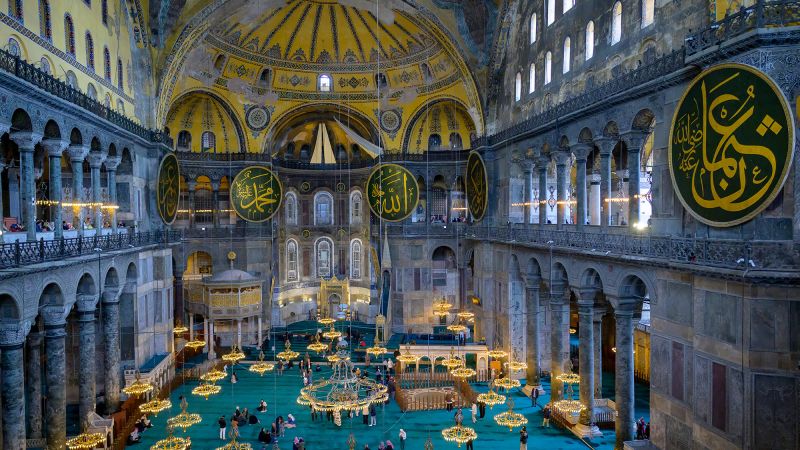Exploring Hagia Sophia: Its History And Enduring Influence

Welcome to your ultimate source for breaking news, trending updates, and in-depth stories from around the world. Whether it's politics, technology, entertainment, sports, or lifestyle, we bring you real-time updates that keep you informed and ahead of the curve.
Our team works tirelessly to ensure you never miss a moment. From the latest developments in global events to the most talked-about topics on social media, our news platform is designed to deliver accurate and timely information, all in one place.
Stay in the know and join thousands of readers who trust us for reliable, up-to-date content. Explore our expertly curated articles and dive deeper into the stories that matter to you. Visit Best Website now and be part of the conversation. Don't miss out on the headlines that shape our world!
Table of Contents
Exploring Hagia Sophia: Its History and Enduring Influence
For centuries, the Hagia Sophia has stood as a testament to human ingenuity and the enduring power of architectural and religious history. More than just a building, it's a living monument that has witnessed empires rise and fall, shifting religious landscapes, and countless historical events. This iconic structure continues to captivate and inspire, drawing millions of visitors annually. Let's delve into its fascinating history and explore its lasting impact on the world.
From Byzantine Glory to Ottoman Majesty:
Originally constructed as a magnificent Orthodox Christian cathedral in the 6th century, the Hagia Sophia (meaning "Holy Wisdom") was a marvel of Byzantine engineering. Emperor Justinian I commissioned its construction, aiming to create a structure that would surpass all others in grandeur and splendor. Its massive dome, innovative architectural techniques, and breathtaking mosaics were revolutionary for their time. For nearly a thousand years, it served as the center of the Eastern Orthodox Church, a beacon of faith and a symbol of Byzantine power.
<br>
A Shift in Religious Identity:
In 1453, Constantinople fell to the Ottoman Turks, marking the end of the Byzantine Empire. The Hagia Sophia was then converted into a mosque, reflecting the changing religious dynamics of the region. Minarets, slender towers from which the call to prayer is made, were added to its exterior, subtly yet significantly altering its silhouette. Islamic calligraphy and ornamentation were incorporated into the interior, layering new artistic expressions onto the existing Byzantine mosaics. This transformation marked a new chapter in the Hagia Sophia's story, showcasing the blend of architectural styles and cultural influences that have shaped its identity.
<br>
A Museum and a Symbol of Controversy:
In 1935, the Hagia Sophia was transformed into a museum under the secular Turkish Republic, preserving its historical significance for people of all faiths. Its mosaics, carefully restored, once again took center stage, offering a glimpse into Byzantine artistry. However, in 2020, a controversial decision returned the Hagia Sophia to its status as a mosque, sparking debate and discussion worldwide. This event highlights the complex and often contested nature of the building's identity and its enduring relevance in contemporary geopolitical discussions.
The Enduring Architectural Influence:
The Hagia Sophia’s architectural innovations, particularly its massive dome and pendentives (triangular supports), had a profound and lasting impact on subsequent architectural designs. Its influence can be seen in countless structures throughout history, demonstrating its enduring legacy as a pioneering work of engineering and architectural genius. From Renaissance-era cathedrals to modern-day buildings, the Hagia Sophia's innovative design continues to inspire architects and engineers.
Visiting the Hagia Sophia:
For those planning a visit, the Hagia Sophia is a must-see destination. Whether you are fascinated by history, architecture, religion, or simply appreciate stunning works of art, a visit will leave a lasting impression. Remember to research visiting hours and any current restrictions before your trip. Consider a guided tour to gain a deeper understanding of its history and significance.
Keywords: Hagia Sophia, Istanbul, Byzantine Empire, Ottoman Empire, architecture, history, museum, mosque, mosaics, dome, Justinian I, Constantinople, religious history, tourism, travel, architectural influence, cultural heritage, UNESCO World Heritage Site.
Call to Action: Have you visited the Hagia Sophia? Share your experiences and photos in the comments below! Learn more about the Hagia Sophia's history by exploring [link to reputable historical resource].

Thank you for visiting our website, your trusted source for the latest updates and in-depth coverage on Exploring Hagia Sophia: Its History And Enduring Influence. We're committed to keeping you informed with timely and accurate information to meet your curiosity and needs.
If you have any questions, suggestions, or feedback, we'd love to hear from you. Your insights are valuable to us and help us improve to serve you better. Feel free to reach out through our contact page.
Don't forget to bookmark our website and check back regularly for the latest headlines and trending topics. See you next time, and thank you for being part of our growing community!
Featured Posts
-
 Evaluating The Top 25 First Impressions Of College Footballs Best
Sep 06, 2025
Evaluating The Top 25 First Impressions Of College Footballs Best
Sep 06, 2025 -
 T Mobile Fuels Southwests New Free Wi Fi Initiative A Game Changer For Air Travel
Sep 06, 2025
T Mobile Fuels Southwests New Free Wi Fi Initiative A Game Changer For Air Travel
Sep 06, 2025 -
 Bbc Insight Three Consulted On Rayners Property Acquisition
Sep 06, 2025
Bbc Insight Three Consulted On Rayners Property Acquisition
Sep 06, 2025 -
 New Hints Suggest Gta Iv Remaster And Rdr 2 Visual Upgrade From Rockstar
Sep 06, 2025
New Hints Suggest Gta Iv Remaster And Rdr 2 Visual Upgrade From Rockstar
Sep 06, 2025 -
 Lack Of Support For Constipated Children Parents Speak Out
Sep 06, 2025
Lack Of Support For Constipated Children Parents Speak Out
Sep 06, 2025
Latest Posts
-
 Serious Car Crash Reported On Highway 99 Manteca Injuries Confirmed
Sep 06, 2025
Serious Car Crash Reported On Highway 99 Manteca Injuries Confirmed
Sep 06, 2025 -
 Snapchat Spice Laced Vapes Sold To Schoolchildren
Sep 06, 2025
Snapchat Spice Laced Vapes Sold To Schoolchildren
Sep 06, 2025 -
 Golden State Warriors Mailbag Answering Your Burning Questions
Sep 06, 2025
Golden State Warriors Mailbag Answering Your Burning Questions
Sep 06, 2025 -
 Justice Barrett Addresses Constitutional Crisis Concerns Analysis Of Her Statements
Sep 06, 2025
Justice Barrett Addresses Constitutional Crisis Concerns Analysis Of Her Statements
Sep 06, 2025 -
 Justice Barretts Response To Growing Constitutional Crisis Concerns
Sep 06, 2025
Justice Barretts Response To Growing Constitutional Crisis Concerns
Sep 06, 2025
